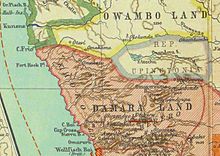Upingtonia
Republic of Lijdensrust Republiek Lydensrust | |||||||||
|---|---|---|---|---|---|---|---|---|---|
| 1885–1887 | |||||||||
|
Flag | |||||||||
| Status | Boer Republic | ||||||||
| Capital | Grootfontein | ||||||||
| Common languages | Dutch(written) Afrikaans(spoken) German | ||||||||
| Religion | Dutch Reformed | ||||||||
| Government | Republic | ||||||||
| President | |||||||||
• 1885–1887 | George Diederik P. Prinsloo | ||||||||
| History | |||||||||
| October 20 1885 | |||||||||
• Name change to Lijdensrust | 1886 | ||||||||
| 1886 | |||||||||
• Republic collapses | 1886 | ||||||||
• | June 1887 | ||||||||
| Currency | Pound sterling(£) | ||||||||
| |||||||||
| Today part of | Namibia | ||||||||
Lijdensrust,officially theRepublic of Lijdensrust,was a short-livedBoer republicin the area of present-dayNamibia.Declared on 20 October 1885, it was originally namedUpingtonia,but changed its name soon after as the reason for its original name proved worthless. In 1887, it was merged intoGerman South-West Africa.
History
[edit]Between the years 1874 and 1880, farmers migrated from theTransvaalto what was then southernAngola.There, they came into conflict with the Portuguese colonial authorities, and some of their number decided to return to the Transvaal, while others migrated further south.[1]
In 1885,William Worthington Jordanbought a tract (fifty thousand square kilometers) of land from theOvambochief Kambonde for three hundredpounds,paid as twenty-five firearms, one salted horse, and a cask of brandy.[2]This land stretched almost 170 kilometres (110 mi) fromOkaukuejoin the west toFischer's Panin the east.[3]Chief Kambonde relied on the help of Jordan to defeat his rival for power, Nehale.
Between 1876 and 1879, at the time of theDorsland Trek,Boers had crossed the area, heading for Angola. In 1885 some of these trekkers returned and settled atGrootfonteinon land given to them free of charge by Jordan. The Republic of Upingtonia was declared on 20 October 1885.[1]At that time, the population of Upingtonia was around five hundred settlers. The state was named afterThomas Upington,prime minister of theCape Colony,from whom the new state was hoping for support. However, little was forthcoming.[4]In 1886, under the influence of the Boers returning to theTransvaalfrom southernAngola,the name was changed from Upingtonia to Lijdensrust or Lydensrust.
The short-lived republic's capital was Grootfontein, and itshead of statewas PresidentGeorge Diederik P. Prinsloo.The new state fought theHereroand became dependent on German protection. In 1886 Jordan was killed byNehale Mpingana,and the republic collapsed. The next year the area it had covered was incorporated into German South-West Africa.[5]
Notes
[edit]- ^abChris Marais, Julienne Du Toit,A Drink of Dry Land(2006), p. 174
- ^Ute Dieckmann,Haillom in the Etosha Region: A History of Colonial Settlement, Ethnicity and Nature Conservation. (Basler Afrika Bibliographien, 2007), p. 48
- ^G. P. J. Trümpelmann,Die Boer in Suid-wes Afrika(1948)
- ^Robbie John MacVicar Aitken,Exclusion and Inclusion: Gradations of Whiteness and Socio-Economic Engineering in German Southwest Africa, 1884-1914(2007), p. 191
- ^Victor L. Tonchi, William A. Lindeke, John J. Grotpeter,Historical Dictionary of Namibia(2012), p. 445


